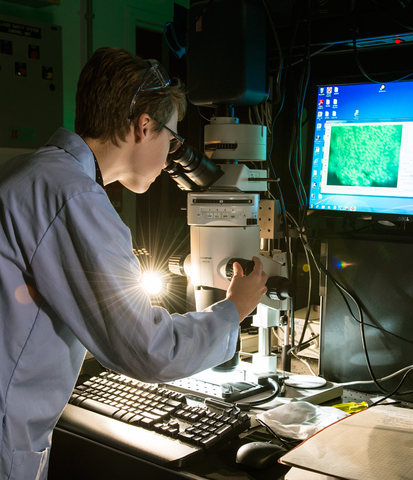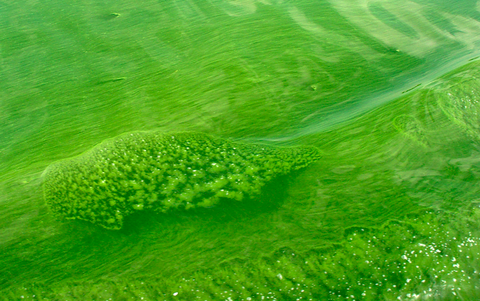Explosive growth of cyanobacteria, also called blue-green algae, is nothing new. In fact, such cyanobacteria probably produced the original oxygen in Earth's atmosphere billions of years ago.
But when certain kinds of cyanobacteria multiply rapidly and release toxins, the result is a harmful algal bloom (HAB), a subject of intense concern to the public-health and ecology communities.
However, "Not all cyanobacteria produce toxins," says Emily Paine of the U.S. Geological Survey (USGS), a guest researcher at NIST who is investigating the optical characteristics of multiple algal species. "So to better localize, track, and understand a threat, we need some way to distinguish the potentially harmful organisms from the harmless, even though they look virtually identical.
"In addition, there are species that only produce toxins sometimes, and ideally we would be able to identify when they are doing so. As of now, some research has been done in distinguishing species that are more likely to be harmful from those that aren't, but directly measuring the current toxicity of a bloom has not been done."
One potential way to do so is with hyperspectral imaging (HSI). Whereas the human eye sees color in three broad bands — red, green, and blue — HSI collects spectral data in dozens of very narrow wavelength bands and builds up detailed composite images, wherein a complete spectrum is associated with every pixel. In that form, each kind of object has a unique spectral signature. USGS has long used the technique to make mineral and vegetation maps, and conduct groundwater surveys.

"If it's possible to discriminate spectrally between harmful and non-harmful organisms, it's going to be a small difference, and hard to tease out from the overwhelming background," Allen says. That's why "we'll also look at individual cells if we can," Paine says, "to try to get specific signatures from individual cells to see what signals we can ignore from the background."
Once the libraries are established, an unmanned aerial vehicle (UAV, or drone) could fly over large areas of bloom at low altitude with an HSI camera and gather data that would later be matched against the library spectra. That would allow officials to identify specific, limited areas containing toxic species and take appropriate action.
"The customary method of getting this kind of 'ground truth' now involves people going out, taking water samples, and bringing them back to the lab for examination under a microscope and biochemical analyses," Allen says. "It's very hard to cover a large area that way, hence the need for remote sensing. You can send airplanes at intervals, but it's comparatively expensive and the altitude may affect the really fine HSI resolution required. UAVs, by contrast, can go any time and fly a programmed route directly over areas of interest."
At present, there is a multi-agency federal effort including NOAA, NASA, EPA, and USGS to provide an early-warning system by processing satellite data to identify algal blooms. One of the most common organisms, Microcystis, can produce a toxin that causes damage to the liver and nervous system in humans, along with other maladies. This genus has been observed in a wide range of freshwater locations, from New England to Florida, the Midwest, and the West Coast. The National Park Service estimates that "at least one-third of lakes in the United States that are larger than 10 acres have Microcystis algae, and this trend is increasing worldwide."
Harmful algal blooms arise from a combination of factors, the interaction of which is not fully understood. One major contributor is runoff from fertilized areas, which increases the amount of key nutrients such as phosphorus and nitrogen available in freshwater bodies. That leads to "overfeeding" and subsequent rapid population growth.


